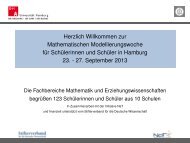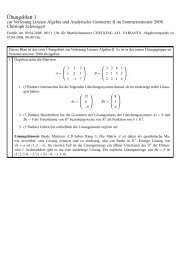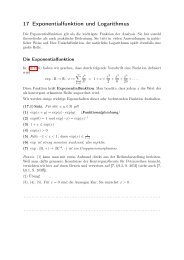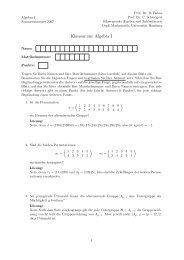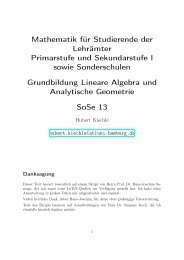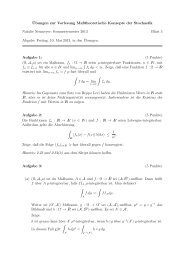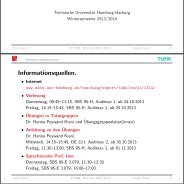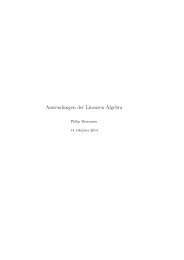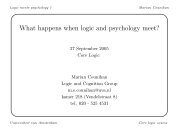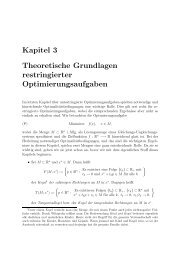pdf file
pdf file
pdf file
You also want an ePaper? Increase the reach of your titles
YUMPU automatically turns print PDFs into web optimized ePapers that Google loves.
splits. Thus H = ker ɛ ⊕ I with I a left ideal of H.<br />
Take z ∈ I and any h ∈ H. Then h−ɛ(h)1 ∈ ker ɛ. Since I is a left ideal, we have h∙z ∈ I.<br />
The direct sum decomposition H = ker ɛ ⊕ I implies<br />
Thus z ∈ I l (H) is a left integral in H.<br />
I ∋ h ∙ z = (h − ɛ(h)1) ∙ z + ɛ(h)z = ɛ(h)z .<br />
} {{ } } {{ }<br />
∈ker ɛ<br />
∈I<br />
Since dim K I = 1, we may choose z ≠ 0. Then z /∈ ker ɛ and thus ɛ(I l (H)) ≠ 0.<br />
2. Conversely, let I be a left integral and assume that ɛ(I) ≠ 0. Replacing I by a scalar<br />
multiple, we can assume that ɛ(I) = 1. Then<br />
s : K → H<br />
λ ↦→ λI<br />
obeys ɛ ◦ s(λ) = λɛ(I) = λ and is a morphism of left H modules, since I is a left integral,<br />
so that the exact sequence (5) splits. Thus the trivial module is projective and the claim<br />
follows from corollary 3.2.12.<br />
✷<br />
Example 3.2.14.<br />
Consider the group algebra K[G] of a finite group G with two-sided integral I = ∑ g∈G<br />
g. Then<br />
ɛ(I) = ∑ g∈G<br />
ɛ(g) = |G| .<br />
Thus the group algebra K[G] is semisimple, if and only if char(K) ̸ | |G|.<br />
Corollary 3.2.15.<br />
If a finite-dimensional Hopf algebra is semisimple, it is unimodular.<br />
Proof.<br />
Since H is semisimple, we can choose a left integral t ∈ H such that ɛ(t) ≠ 0. Then for any<br />
h ∈ H, we have<br />
α(h)ɛ(t)t = α(h)t 2 = (th)t = t(ht) = ɛ(h)t 2 = ɛ(h)ɛ(t)t ,<br />
where we used the definition of a left integral and of the distinguished group-like element α of<br />
H ∗ . Since ɛ(t) ≠ 0, we have α(h) = ɛ(h) for all h ∈ H which implies unimodularity by corollary<br />
3.1.16. ✷<br />
We recall the notion of a separable algebra over a field K. To this end, let A be an associative<br />
unital K-algebra. The algebra A e := A ⊗ A opp is called the enveloping algebra of A. If B is an<br />
A-bimodule, it is a left module over A e by<br />
(a 1 ⊗ a 2 ).b := (a 1 .b).a 2 .<br />
Conversely, any A e -left module M carries a canonical structure of an A-bimodule with left<br />
action a.m := (a ⊗ 1).m and right action m.a := (1 ⊗ a).m. Thus the categories of A e -left<br />
modules and A-bimodules are canonically isomorphic as K-linear abelian categories.<br />
69




